We Have Solar at Home Part 8: The PG&E Bill
Next: We Have Solar at Home Part 9.
Previously: We Have Solar at Home Part 7.
How much did PG&E charge us for electricity in 20231, First Half of Second Try
It’s time to dig into the bills. Five factors complicate a PG&E bill; NEM, a CCA, a CCA with NEM, special rebates and charges, and spite2.
The basics of billing when you have both NEM and CCA
Reminder: NEM2 is Net Energy Metering the program that forces the for-profit power companies to reimburse customers with solar power when they generate more power than they need and send the surplus back to the grid. It was replaced by NEM3 in 2023, which is a much worse deal for home-owners, but probably won’t matter unless you make a big surplus.
IOU is Investor-Owned Utility, the for-profit power company you know and love and are forced to use by a legally granted monopoly. For 5.2 million households in northern California, including ours, this is Pacific Gas & Electric.
CCA is Community Choice Aggregators, the program that forces power companies to let customers get their energy from a government-owned entity, although the power companies still distribute it. Ours is CleanPowerSF.
In practice3:
- You still have a single electric bill, from your IOU
- You have to pay a minimum amount to the IOU every month.
- You pay the IOU once a year, for the net amount of energy delivered over the last year, minus the monthly minimums you
already paid.4
- Credit for surpluses is tracked separately for each
rate.5
- If that net amount is a surplus, the IOU pays you a few pennies per kW·h,
less with NEM3.6
- You have a separate NEM balance with the CCA.
- CleanPowerSF's NEM billing
policy7 is, if you were a net importer for the billing cycle, you pay in full that cycle …
- … and if you were a net exporter, you get a credit
deficit8.
The reason is that getting a rebate requires running a net surplus for the year. I think; that didn’t happen with us so I don’t have direct evidence.
Decrypting the PG&E bill
We’ll start with a relatively simple bill and then show the complications as distinctly as we can. We are skipping any page that doesn’t relate to electricity. Current charges are circled in red. Any number not circled is not yet a charge, and may never be.
Page 1: Account Summary
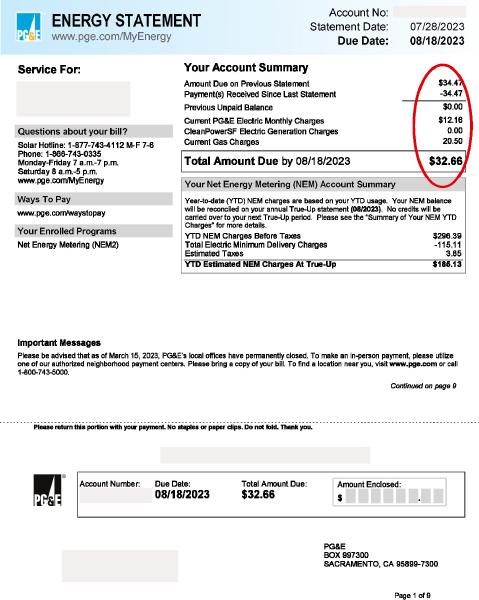
PG&E Bill 2023-07, Page 1
The Account Summary on page one is real; this is money actually changing hands right now9. Here in July 2023, the bill is $32.66. $20.50 is for gas, which we’ll ignore. PG&E is charging $12.16 for electricity, which will be explained on page 5 of the bill. CleanPowerSF is charging $0, which will be explained on page 7.
Page 3: PG&E NEM Year-to-Date10
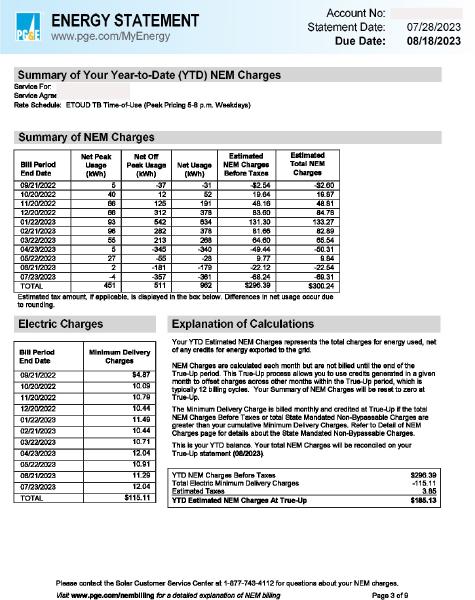
PG&E Bill 2023-07, Page 3
These are our PG&E NEM charges. In this July 2023 bill, we’re one billing period short of true-up. PG&E has provided 962 kW·h net, and wants to charge $300.24. However, we’ve already paid11 $115.11 in monthly minimum fees, and some taxes keep skittering around, so PG&E expects to bill $185.13 next monthly period if nothing changes.
Page 4: PG&E NEM Year-to-Date in chart form

PG&E Bill 2023-07, Page 4
This is a graph of the information from page 3, in case you are a visual learner.
Page 5: PG&E Monthly Charges

PG&E Bill 2023-07, Page 5
This page shows how the Minimum Delivery Charge from page 1 was calculated—a CPUC-set flat fee of $0.3761212 for each day that there was service, plus a SF Prop C Tax Surcharge which PG&E is trying to trick you into thinking is a city tax it has to pass on—it’s actually a payroll tax for companies doing business in San Francisco.
It appears that PG&E has been collecting a “PROP C TAX SURCHARGE” from its San Francisco customers, and is mischaracterizing the surcharge as a tax that Proposition C requires to be collected from its customers. Proposition C imposes the tax on businesses, not the business’ customers. Although PG&E obtained a ruling from the California Public Utilities Commission allowing it to impose and collect a surcharge despite the City’s objections, Proposition C does not require businesses to shift their tax burden to their customers by way of any surcharge.—SF Treasurer & Tax Collector13
The Imports and Exports on the right side are the source of our data about how much energy the house is swapping back and forth with PG&E14. If you want to know exactly what they mean, the PG&E bill explainer will tell you it’s “Details about your electric meter. Your meter tracks your electricity usage.”15 Which is useless, so everything you’ve read here about Import and Export is my assumptions based on the numbers.
Page 6: Details of PG&E Monthly Charges

PG&E Bill 2023-07, Page 6
This page is labeled Details of NEM Charges; that should be read as Details of the PG&E Electricity charges billed to your NEM account for this billing period, with some adjustments caused by or relevant to NEM. There’s a lot to dig into, so let’s start by noting that, with NEM, this is not a real charge. It’s a calculation of what we would have been charged without NEM. With NEM, it’s the contribution of this billing cycle to the pending annual PG&E NEM true-up. Note further that it’s separate from the CleanPowerSF NEM, which we’ll see on the next page. Note lastly that it’s split into two parts, 06-22-2023 — 06/30/2023 and 07/01/2023 — 07/23/2023. That’s because the billing period spans a rate change on July 1st.
Net Usage
This is the charge for the energy the household used from PG&E, based on the amount Imported (to the house) minus the amount Exported (from the house), or the “Net Usage”. The rates here are the PG&E total rates, including both delivery and generation, without regard to the CCA. We generated more energy than we consumed, so this number is negative. It’s a credit, not a charge.
State Mandated Non-Bypassable Charge
This is a Mandated Charge in the sense that the IOUs had their CPUC regulators let them shift their own costs to other entities and force—mandate, if you will—ratepayers to eat the charges. PG&E made money selling energy from nuclear power plants, for example, , but doesn’t think it’s fair for the shareholders who benefited from that business to have to pay all of the costs associated.
The State Mandated Non-Bypassable Charge totals $8.43; this seems to be unrelated to the Minimum Delivery Charge, which was $12.16 this period. It’s explained as Public Purpose Programs, Nuclear Decomissioning, Wildlife Fire Charge, and Competetion Transition Charges. Some of those names are, well, not explained so much as expanded into more words, on the PG&E Understanding Your Bill16 webpage. But I still don’t understand my bill. For examples:
Competition Transition Charges: Charge for legacy electricity contracts, signed prior to 1998, that exceed a CPUC-approved market price limit.
and
Your bill for electric service includes a charge that has been approved by the CPUC to repay bonds issued for certain costs related to catastrophic wildfires. The Recovery Bond Charge (RBC) rate is currently $0.00597 per kWh.
Why am I paying for this? Why isn’t PG&E paying for this out of its profits from back when it was making money and causing catastrophic wildfires? And if it doesn’t have enough money, why didn’t it go bankrupt and get taken over by the state17?
NBC Net Usage Adjustment
This is listed before the State Mandated Non-Bypassable Charge, but I’m attempting to understand it after. It’s $11.78 for this billing period, and it’s supposed to “to ensure that you don’t pay for NBCs twice”. And back in January, when we used $634 kW·h, it was negative while the State Mandated Non-Bypassable Charge was positive. But it’s positive this billing cycle, which makes it seem more than double the State Mandated Non-Bypassable Charge. I guess that makes sense somehow to someone?
Generation Credit
The amount PG&E would have charged you if it provided your generation service. Because you’re getting your electricity from [MCE], PG&E credits this fee back to you. 18
Important Note: This is not about solar panels. This is all about CCAs, where you buy your energy from one company and pay PG&E to deliver it. This is the credit that keeps you from paying both companies for the same energy. You have this on your bill if you have a CCA, whether or not you have solar panels.
Remember how we pay CleanPowerSF for procuring the actual energy to be delivered, but a few lines above we were charged full price from PG&E for that power. This offsets that. This is not directly unrelated to what we pay CleanPowerSF. To figure out what this is supposed to be, we need the Unbundled Rate, where generation and distribution are separate. We need to find our Electric Rates12 document, which since 2019 comes in the form of an Excel spreadsheet. Since a rate hike landed in the middle of this billing period, let’s use the latter rate, JUL 1, 2022 —. AUG 31, 2023. Can you find the unbundled charges in this document?
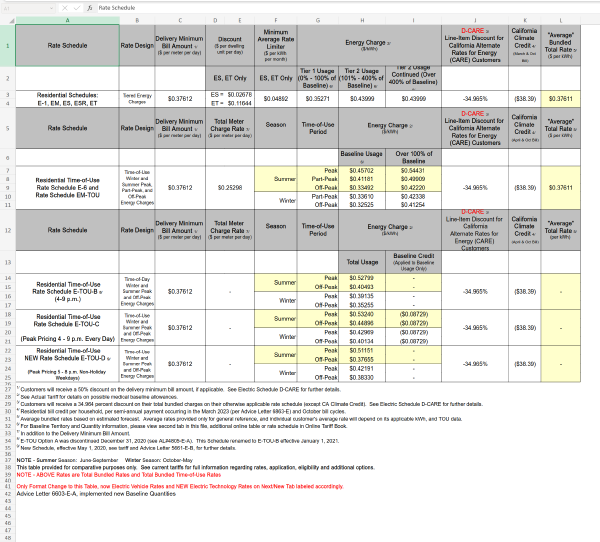
RES Inclu TOU_230701-230831
Thanks for trying, but your Unbundled Charges are in another Tariff19, which you may find if you rummage around the internet enough. This document has the details missing from the spreadsheet, but only the version in effect is listed. So you can get historical rates, or detailed rates, but not detailed, historical rates. At least we finally get to the meat of CCA billing:
… Community Choice Aggregation (CCA) Generation Service Customers purchase energy from their non-utility provider and continue receiving delivery services from PG&E. These customers shall pay all charges shown in the Unbundling of Total Rates except for the Bundled Power Charge Indifference Adjustment and the generation charge. These customers shall also pay for their applicable Vintaged Power Charge Indifference Adjustment provided in the table below, the franchise fee surcharge provided in Schedule E-FFS, and the Generation Service from their non-utility provider. Exemptions to charges for DA and CCA customers, including exemptions for Medical Baseline and continuous DA service, are set forth in Schedules DA CRS and CCA CRS.
And here, finally, are the numbers that should explain the Generation Credits line in the bill—at least in principle, since these are July 2024 values but we’re looking at an July 2023 bill.
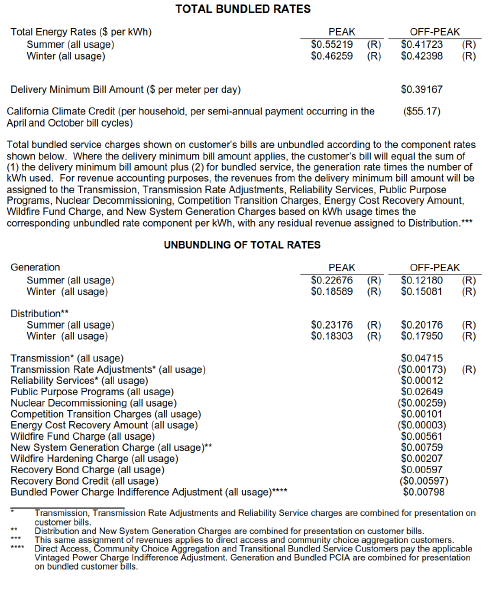
Electric Schedule E-TOU-D Sheet 2
The Bundled Power Charge Indifference Adjustment is $0.00798/kW·h, but “Community Choice Aggregation … Customers pay the applicable Vintaged Power Charge Indifference Adjustment”. The “2022 Vintage” rate on sheet 4 is $0.00085. Does that mean this rate is really $0.00085 for our house? Forever? The generation charge is four charges, for Summer and Winter Peak and Off-Peak, and as of July 2024 they range from $0.22676 to $0.12180, but that won’t match the July 2023 bill. We can try, though: for the portion of July 2023 on this bill, we used -281 kW·h off-peak and only -1 kW·h peak, so that would be about $34.28, which is pretty close to the $36.74 on the bill. Since this billing period was net Export, that means that, instead of getting $105 credit for giving PG&E back off-peak summer power that we would have paid $105 for it went the other direction, we actually would only have paid PG&E 105 - 35 = about $70. Give or take the various smaller fees, the one-year mismatch in rates, and the week of energy in June, that’s pretty close to the -$69.31 on the bill, so this tariff document may well be the source of this number.
Power Charge Indifference Adjustment
This is where IOUs penalize CCA customers for leaving. The theory, I think, is that the IOUs made investments and assumptions based on certain growth patterns based on previous laws, and when the legislature changed the law in 2012, they undercut those assumptions, and we must think about the shareholders …20
Franchise Fee Surcharge
This pays for “PG&E’s right to use public streets to run electricity service to your home.”18
SF Prop C Tax Surcharge
As we saw above, this is a “mischaracteriz[ation]” of a business payroll tax21.
Monthly NEM Charges
Taking into account all of the money we didn’t pay, would have paid, wouldn’t have not paid, etc, this month put $69.31 into our NEM account. If you go back to page 4, you can see that reflected in the negative bar in the 7/23 column of NEM Charges Before Taxes and in the dip in the Cumulative NEM Balance by Month. If that curve was on track to drop to zero in one more month, we would be generating all the energy we need, but that’s clearly not going to happen.
Page 7: CleanPowerSF
Whereas PG&E took four pages to explain our electricity charges, CleanPowerSF does it in one page. Because we were in surplus for the billing period, our charge is $0, and that’s where the number on the first page comes from.
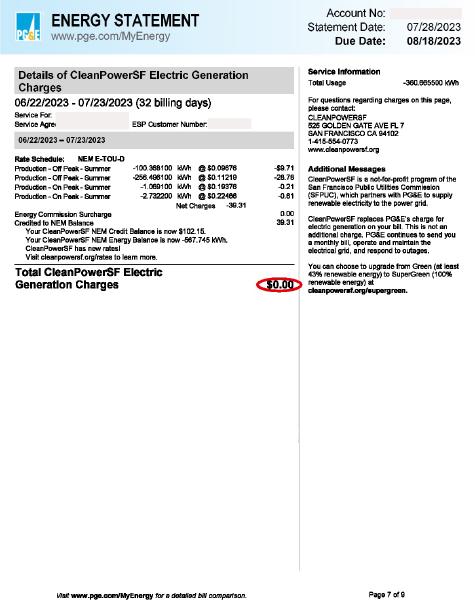
PG&E Bill 2023-07, Page 7
There is one slightly confusing thing on this page, though: what’s the deal with having both a CleanPowerSF NEM Credit Balance and a NEM Energy Balance. Is this the same quantity thing in two forms? We’re not finished with these bills, so Let’s come back to this next week, when we look at a net-deficit billing cycle.